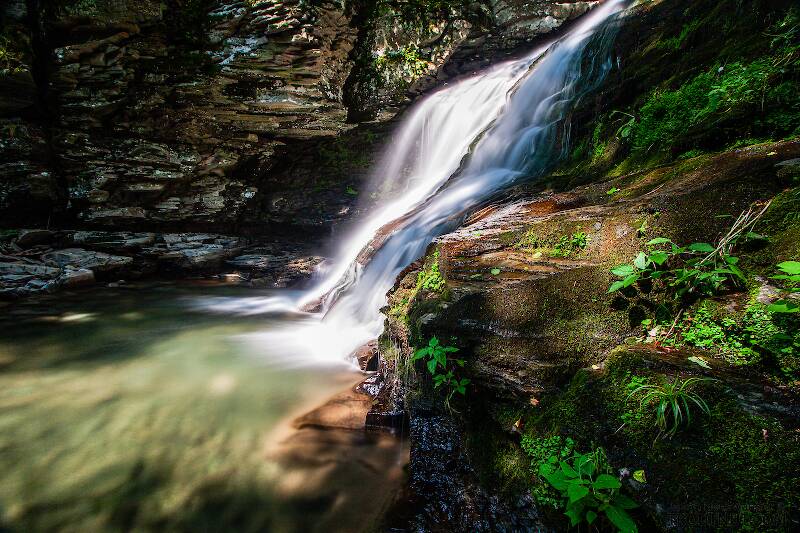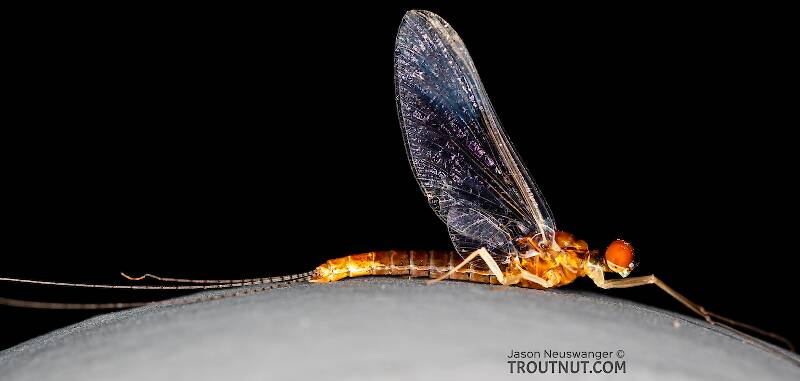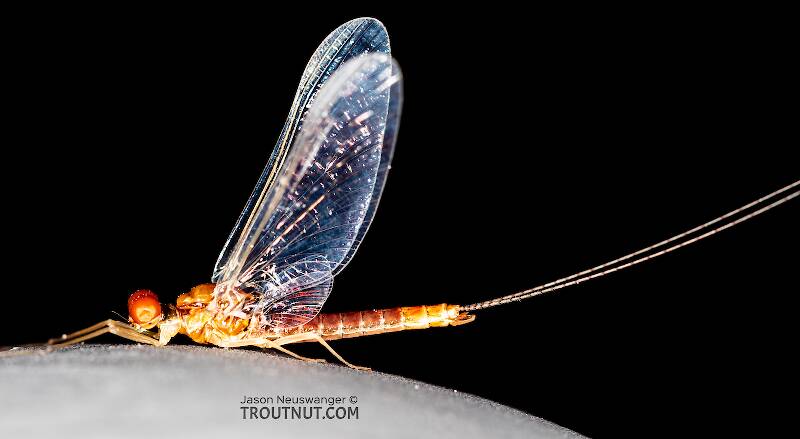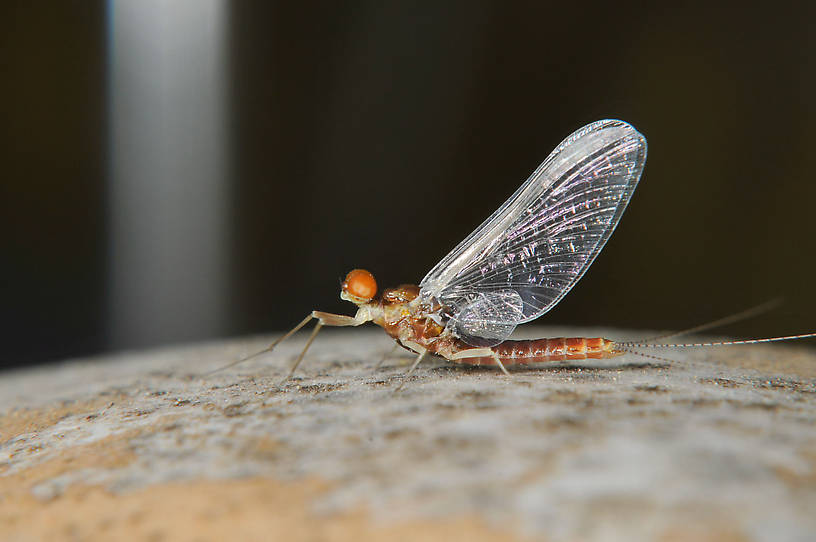
Salmonflies
Pteronarcys californica
The giant Salmonflies of the Western mountains are legendary for their proclivity to elicit consistent dry-fly action and ferocious strikes.


Mayfly Species Ephemerella dorothea infrequens (Pale Morning Duns)
This taxon used to be considered the separate species Ephemerella infrequens, but entomologists now regard it as a subspecies together with the small eastern Pale Evening Dun hatch Ephemerella dorothea dorothea. There is another related listing of significance common in California and the Southwest that has undergone revision. The large (often exceeding 10 mm) Ephemerella mollitia is now considered synonymous with d. infrequens.
While it is not the normal policy of TroutNut to list subspecies as separate taxa, d. infrequens and d. dorothea are so important and distinct from each other in terms of geography, appearence, and angling tradition that they warrant an exception.
Where & when
Time of year : March-August, best in May-June in the coastal states;July-August in the Rockies
Preferred waters: All types, but especially abundant in alkaline spring creeks.
Altitude: From near sea level on some West Coast tailwaters to as high as 8,000 ft.
In 13 records from GBIF, adults of this species have been collected during June (46%), July (23%), August (15%), and May (15%).
In 15 records from GBIF, this species has been collected at elevations ranging from 5066 to 9193 ft, with an average (median) of 6670 ft.
Species Range
Hatching behavior
Classic surface emergers with long sedate floats in optimal weather. Have been reported to emerge subsurface in faster flows. They usually engage in "practice runs" exposing the nymphs to trout during extended pre-hatch periods.Spinner behavior
Time of day: Usually morning and often again near dusk
Habitat: Riffles are preferred in freestone environments. Spring creek dwellers prefer specific locations determined by a variety of factors.
Females often, but not always, drop their eggs from the air above the stream. When they do end up on the water with egg sacs still attached, trout may become selective to spinners with little bright yellow dots near the tail and upright wings as well. The gravid females are often active and far from "spent". Spent spinners usually cause the most feeding activity. Both male and female are usually similar enough that the same pattern can work for both, though the angler should take note of the differences in size between the sexes as the fish can become selective to one or the other. thogh often seen in the evening, mid- morning spinner falls have achieved legendary status at many locations.
Nymph biology
Diet: Detritus, algae
Current speed: Can be found in all current speeds, but especially near vegetation.
Substrate: Gravel, sand, vegetation
Physical description
Most physical descriptions on Troutnut are direct or slightly edited quotes from the original scientific sources describing or updating the species, although there may be errors in copying them to this website. Such descriptions aren't always definitive, because species often turn out to be more variable than the original describers observed. In some cases, only a single specimen was described! However, they are useful starting points.
Male Spinner
Wing length: 9 mm
A species of the Ephemerella invaria group; second joint of forceps swollen at apex; nymph without dorsal spines, and with no pale spots on posterior margins of tergites.
Eyes of living male light orange. Head light brown, clypeus and bases of antennae pale yellow. Pronotum and the lateral edges of the mesonotum anterior to the wing base purplish brown. Mesonotum deep olive brown, becoming reddish brown posteriorly; two slightly raised blackish lines anterior to the scutellum. Bases of wings and the pleural sutures tinged with yellowish brown. Prosternum yellowish; remainder of sternum brown. Legs light yellow, the fore tibiae and tarsi rather duller than the femora; tarsal joints slightly marked with brown. Wings hyaline; venation pale; cross veins indistinct, especially in the basal portion of the costal space.
Abdomen light reddish brown dorsally; posterior margins smoky. A narrow yellowish line along the pleural fold. Dull purplish brown ventrally, shading into yellowish brown on the apical sternites. The middle sternites show traces of pale semi-translucent areas along the anterior margins. Forceps yellowish, penes similar, with a darker transverse band near the base. Tails yellowish at the base, whitish beyond; joinings narrowly deep brown. Usually four apical spines on the penes, and four or five others lower down, in two irregular groups (see fig. 152).
Described as E. mollitia
Body length 10 mm, wing length 10 mm
A species of the Ephemerella invaria group; spines on the penes more numerous than in any other species of this group; venation pale.
Eyes salmon pink in life. Antennae purplish black at base, second joint pale; filament dark brown (in alcoholic specimens, rather pale.) Thorax deep yellow, shading into deep orange on the median line, the lateral margins of the mesonotum above the wing roots, and the lateral margins of the scutellum. Scutellum margined narrowIy with brown. Anterior and posterior margins of pronotum, the median line, and markings on each side of the median line, purplish black. Deep pinkish to orange at the base of each leg. Legs pale (in life the fore leg may have had a ruddy tinge); tarsal joinings of the fore leg narrowly brownish. Wings hyaline; venation pale yellowish to hyaline.
Basal and middle abdominal tergites deep reddish; posterior margins rather widely purplish black, the anterior margins paler (probably the “white or translucent joinings” of the original description). Apical tergites yellowish, tinged with reddish laterally. Pleural fold pale on the extreme margin; an interrupted dark line parallels it closely on each tergite. Ventrally paler, the basal and middle sternites tinged with reddish. Forceps smoky brown, penes pale. Tails white, the joinings black. 24 to 28 spines on the penes; an apical cluster consisting of 4 to 6 spines on each side, and others irregularly arranged further back toward the base (see fig. 152).
Nymph
The nymph is dark reddish to blackish brown in color. Antennae dark brown at base, remainder yellowish. Vertex of head, each side of the pronotum, and the mesonotum anterior to and between the wing roots, indistinctly mottled with darker brown; these mottlings are much less apparent than in the very similar nymph of E. inermis (now a synonym of Ephemerella excrucians). Legs reddish brown; femora blotched irregularly with yellowish; tibiae and tarsi each pale-banded near the base and again at the apex. Femora with the usual posterior spines; fore femur with spines as usual on the upper surface near the apex. 5 to 6 denticles on each claw. No dorsal abdominal spines. Lateral extensions present, but slightly less developed than in E. inermis, and lacking the dark mark across the middle, which is present in the latter species. No pale spots at the posterior margins of the tergites, near the median line, such as are present in E. inermis and E. mollitia (now a synonym of Ephemerella dorothea infrequens). A pale mid-dorsal line is usually present. Pale lateral areas, if present, are inconspicuous and hidden beneath the gills; often these are entirely wanting. Venter without conspicuous markings. Tails reddish brown, crossed by several yellowish bands.
Described as E. mollitia
Nymph reddish brown; very similar to E. inermis (now a synonym of Ephemerella excrucians), but with fewer bands on the tails. Vertex and occiput of head, the pronotum on each side, and the mesonotum anterior to and between the wing roots, mottled with irregular dark reddish brown spots, which are surrounded by a yellowish ground color. Lateral margins of the pronotum pale yellowish. Genae show a slight tendency toward lateral development. Legs pale reddish to greyish brown; femora indistinctly mottled. A brownish band at the base of tibia and tarsus; another dark band beyond the middle of the tibia. Short spines on the posterior margins of the femora, and the anterior margins of tibiae and tarsi; shorter spines on the upper surface of the fore femur near the apex. 8-10 denticles on each claw. Lateral extensions of the abdominal segments well developed. Dorsal spines absent. Two pale spots on the posterior margin of each tergite, one on each side of the median line. Faint indications of a pale median line and of pale submedian streaks, on the middle tergites. Larger pale areas are usually present laterally, just above the gills, on tergites 3-7; most extensive on tergite 5. Tails yellowish. In mature nymphs, each joining in the basal half appears black-ringed, due to the subimaginal tail within. In younger nymphs, tails pale except for one or two dark basal rings.
Specimens of the Mayfly Species Ephemerella dorothea infrequens
1 Male Dun
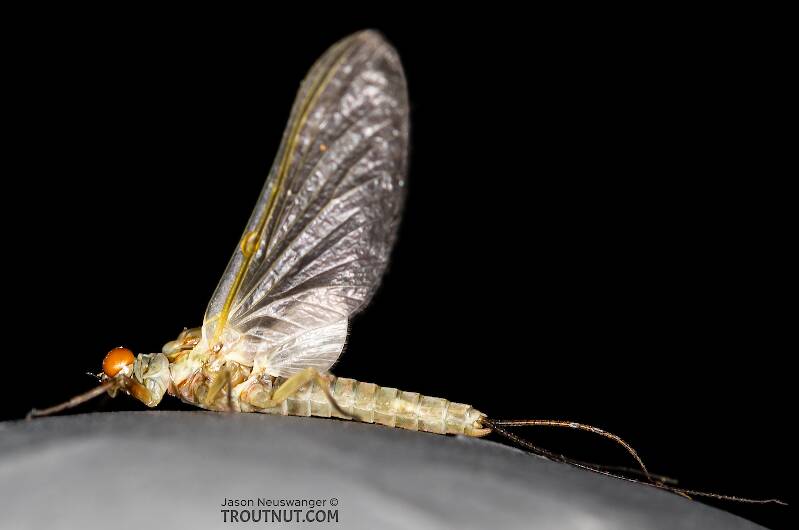
3 Male Spinners
1 Female Spinner
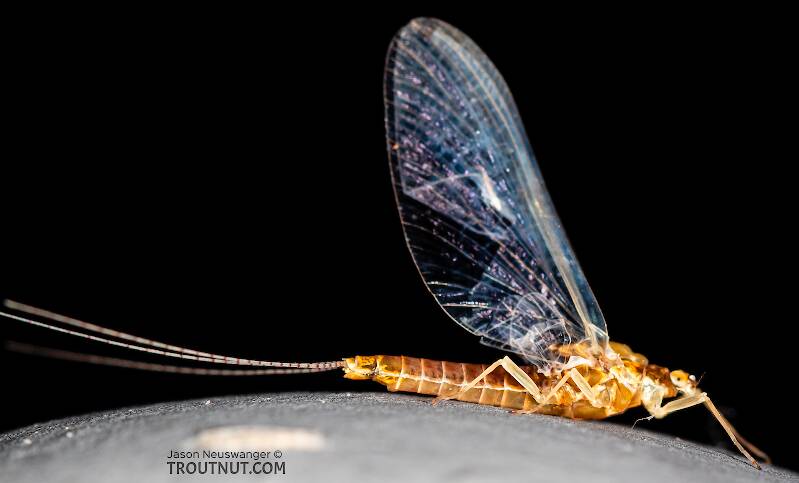
1 Nymph
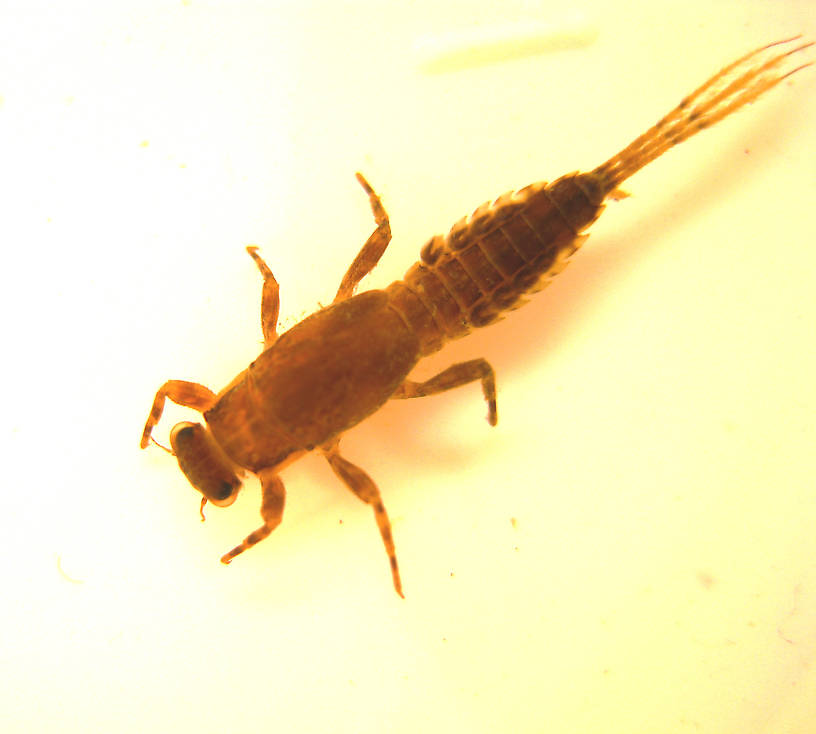
Size: 8.5 mm. Mature specimens have been captured as large as 10.5 mm.
Emergence schedule: Variable - starting as early as mid March and lasting as late as early June, depending on the year. Usual duration is at least several weeks or more.
Dun Association: Body is elusive pale creamy yellow w/ orange highlights, cream legs and tails, and dun wings
Specimen status in photo: Preserved
Collection method: Kick net
Comments: Extremely common in samples taken from this location. It's color in life was very close to as depicted in the photo; except for the gradual darkening of the abdominal segments as they progress posteriorly, which has been accentuated somewhat by the effects of preservation. Adult association is based upon capture of this taxon at various stages of emergence including: darkened wingcases, split thoraxic notums, and partially ecloded or ''stillborn'' specimens.
Entoman
Discussions of Ephemerella dorothea infrequens
Start a Discussion of Ephemerella dorothea infrequens
References
- Arbona, Fred Jr. 1989. Mayflies, the Angler, and the Trout. Nick Lyons Books.
- Caucci, Al and Nastasi, Bob. 2004. Hatches II. The Lyons Press.
- Knopp, Malcolm and Robert Cormier. 1997. Mayflies: An Angler's Study of Trout Water Ephemeroptera . The Lyons Press.
- Needham, James G., Jay R. Traver, and Yin-Chi Hsu. 1935. The Biology of Mayflies. Comstock Publishing Company, Inc.
Mayfly Species Ephemerella dorothea infrequens (Pale Morning Duns)
Species Range
Common Name
Resources
- NatureServe
- Integrated Taxonomic Information System
- Global Biodiversity Information Facility
- Described by McDunnough (1924)

